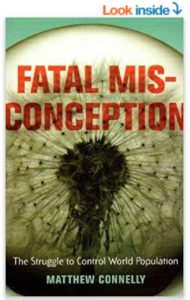N.I.C.E and Foreign Aid for Population Control
New frontiers of scientific discovery can fill us with wonder and excitement. New planets or meteors or subatomic particles discovered, or new medical breakthroughs to cure diseases, new flying cars, energy sources, or nanotech materials.
Other discoveries and technology advances though, can spur new fears. Artificial intelligence advances could displace millions of workers, or new rogue robots could kill millions. Sometimes scientific advances create public policy fears and spur new legislation.
So it was with the scientific breakthroughs announced for eugenics in the early 1900s. Previous posts have discussed the eugenics era and its influence on U.S. immigration and foreign aid policies.
Drawn from Charles Darwin’s theory of evolution, the fear was that mankind was evolving the wrong way, down rather than up. One of the goals of the National Institute for Coordinated Experiments (NICE) in C.S. Lewis’s novel That Hideous Strength, was getting on with improving the human race
[Feverston explains] Man has got to take charge of Man. That means, remember, that some men have got to take charge of the rest…
[Mark asks] What sort of things have you in mind?
[Feverston continues] Quite simple and obvious things, at first–sterilization of the unfit, liquidation of backward races…selective breeding. Then real education…I mean one that has no ‘take-it-or-leave-it’ nonsense. A real education makes the patient what it wants infallibly: whatever he or his parents try to do about it. Of course it will have to be mainly psychological at first. But we’ll get on to biochemical conditioning in the end and direct manipulation of the brain…
Science was thought to offer solution to the world’s problems, and among the first of those problems was too many people, and the wrong kind of people. Matthew Connelly’s 2009 book Fatal Misconception: The Struggle to Control World Population tells the sad story that cost so many their lives and so many women their fertility.
The Fatal Misconception Harvard University Press page has information on the book plus reviews:
Fatal Misconception is the disturbing story of our quest to remake humanity by policing national borders and breeding better people. As the population of the world doubled once, and then again, well-meaning people concluded that only population control could preserve the “quality of life.” This movement eventually spanned the globe and carried out a series of astonishing experiments, from banning Asian immigration to paying poor people to be sterilized.
A PovertyCure YouTube segment features Carroll Ríos de Rodríguez discussing foreign aid funded population control programs:
https://www.youtube.com/watch?v=DNANQ-p-AQc
Continuing from the Harvard University Press Fatal Misconception page:
Supported by affluent countries, foundations, and non-governmental organizations, the population control movement experimented with ways to limit population growth. But it had to contend with the Catholic Church’s ban on contraception and nationalist leaders who warned of “race suicide.” The ensuing struggle caused untold suffering for those caught in the middle—particularly women and children. It culminated in the horrors of sterilization camps in India and the one-child policy in China.
Students can research the online debate about foreign aid for population and family planning programs. Many earlier posts discuss population issues.
This post prepared for a U.S./China debate topic, The Legacy of China’s One-Child Policy (EconomicThinking, December 20, 2016) has links to further resources and discussions.

